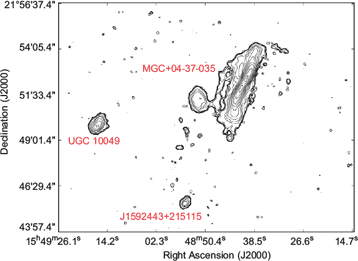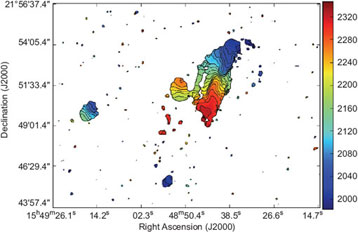Discovery of a Small Group Driving the Evolution of an
Edge-On Spiral Galaxy
UGC 10043 is an edge-on, spiral galaxy located ~32 Mpc from us that was found to have several morphological peculiarities by Matthews & de Grijs (2004). In particular, optical images show that the bulge of UGC 10043 is elongated perpendicular to the major axis of the galaxy, and is bisected on its southwest quadrant by a dust lane parallel to the minor axis. Additionally, there are signs of a large-scale galactic wind, probably powered by a faint central starburst. The stellar disk is thin, dusty, and dynamically cold.
Such structural complexities relate UGC 10043 to relatively rare objects like orthogonally decoupled bulge systems (Bertola, 1999) and polar ring galaxies (Whitmore et al., 1990), all of which exhibit components with angular momentum parallel to the galaxy’s major axis. Orthogonal rotation indicates a peculiar formation history that must have included a significant “second event” like a merger or accretion, which can play a key role in the evolution of massive galaxies. In the case of UGC 10043, Matthews & de Gris (2004) proposed three plausible formation scenarios: accretion of gas around a pre-existing spheroid (Dressing a Naked Spheroid), acquisition of a bulge after the disk had already formed and settled (Capture), and simultaneous formation of disk and bulge through the merger of two moderate-size galaxies.
Our goal is to gain further insight into the structure and kinematics of gas in UGC 10043 so as to constrain its history and discriminate between possible evolutionary models, which will allow us in turn to understand how the outcome of second events are affected by the properties of participating galaxies. We therefore observed UGC10043 with the VLA in HI spectral imaging mode, using the C and D configurations. Our results were presented at the 211th AAS Meeting (Aguirre, Uson & Matthews 2007).

Figure 1. Integrated HI flux map. Contours plotted are 5.823 × 10-1 (0.3,0.5,1,1.4,2,2.0,4,5.6,8,11,16,22,32,44,64,88,100) Jy bm-1.
The VLA data were reduced using standard AIPS routines and the squint-correcting algorithm (Uson & Cotton 2008) available in the Obit software package (Cotton 2007), from which we obtained channel images and moment maps. For UGC 10043 we measured a total flux of 22.19±0.14 Jy km s-1, in good agreement with previous observations (Giovanelli, Avera & Karanchentsev 1997). We also detected emission from three neighboring galaxies, MGC+04-37-035, UGC 10049, and J1592443+215115, which reveals a small group environment as seen in Figure 1. UGC 10043 and MGC+04-37- 035 are physically connected by a continuous gas bridge that runs parallel to the major axis of the galaxy and falls on top of the bulge of UGC 10043, close to the location of the minor axis dust lane. The gaseous disk of UGC 10043 extends ~3 times further than the optical component, and displays an integralsign warp that could originate from interaction with MGC+04-37-035, since it has been shown that warps can be excited by infalling satellites (Huang & Carlberg 1997, Velázquez & White 1999). We also detect radio continuum emission in UGC 10043 that is consistent with a central star-formation origin according to the radio continuum/ IR relationship (Condon et al., 2002) and with the lack of a nuclear source in 4.9 and 8.4 GHz observations (Hummel et al., 1993, and VLAArchive Data).
To analyze the system’s kinematics, we produced the map of the first moment shown in Figure 2. For UGC 10043, the velocity field shows the typical structure of a differentially rotating disk with angular momentum oriented along the south-west direction, smooth velocity transitions and V-shaped isovelocity contours. In the case of MGC+04-37-035, there are also signs of a rotating disk but the isovelocity contours are less pronounced due to its lower inclination angle and, most important, the rotation direction is opposed to that of UGC 10043. The velocity transition along the connecting gas bridge is very smooth, reinforcing the idea of a physical association. The fact that they are counterrotating is an important factor in the analysis of the interaction, because it determines how strongly the encounter affects them. We also detect a collection of small HI clouds forming arcs at the NW edge of UGC 10043 and SE border of MGC+04-37-035, which appear to trace an open orbit.
We built rotation curves for both galaxies using the “terminal velocity method” (Shane & Biegert-Smith, 1966), and derived their dynamical parameters. For UGC 10043 we obtain a systemic velocity of 2162.4±1 km s-1, in good agreement with published results (Matthews & de Grijs 2004, Springob et al. 2005), and a maximum relative velocity of 163 km s-1. For MGC+04-37-035, the maximum velocity is ~100 km s-1, which translates into a dynamical equilibrium mass of ~2.5×1010M⊙. This value is 100 times larger that the measured HI mass, so even if we accounted for the stellar and dust components the assumption of equilibrium would require MGC+04- 37-035 to be more dark-matter dominated than most known galaxies. In turn, it is more likely that MGC+04-37-035 is perturbed and excited by the interaction with UGC 10043, which probably affected its spiral structure and accounts for its irregular flocculent appearance, with bright star-forming knots and rudimentary spiral arms (Matthews & de Grijs, 2004).
Regarding UGC 10043’s morphological peculiarities, the smoothness in the velocity field shows no multi-spin components in the HI structure of UGC 10043, and no signs of a classic polar ring. We see no bowl-shaped structures around the bulge region either, as expected if the galaxy had captured a pre-existing spheroid.

Figure 1. HI velocity field for UGC 10043. Contours are plotted over a linear color map of the velocity field map, ranging from 1956.92 to 2364.98 km s-1, with a separation of 15.6 km s-1. This is equivalent to plotting one of every two channels. The colorbar shows values of velocities in units of km s-1.
Our HI observations reveal that UGC 10043 is affected by an ongoing interaction with MGC+04-37-035, which may account for some of the morphological peculiarities described by Matthews & de Grijs (2004). First, the gas tidally stripped from MGC+04-37-035 is being dumped onto the central region of UGC 10043, so it can therefore be related to the minor axis dust lane and would also help fuel the central starburst that powers the large scale galactic wind and radio continuum emission. The interaction is also consistent with the excitation of a warp in the gaseous disk, and the fact that the galaxies are counterrotating is compatible with the thin and dynamically cold stellar disk, because Nbody simulations have shown that disks are less heated in retrograde encounters (Velázquez & White, 1999).
The complex configuration revealed by HI data reinforces the conclusion that UGC 10043 has had a peculiar formation history, and the new data can help us discriminate between models. The first scenario proposed by Matthews & de Grijs, Dressing a Naked Spheroid, could be supported by the ongoing accretion of gas from MGC+04-37-035, but this galaxy lacks enough mass to account for the whole disk of UGC 10043. An alternative is the capture of a small, gas-poor elliptical, but this mechanism would produce bowl-shaped or ring structures around the bulge region (Matthews & de Grijs, 2004), which are not noticeable in our maps. Finally, a major merger in the past cannot be discarded, and in fact it is likely that the current interaction is actually a “third event” that is adding material to a pre-existing prolate bulge made of old, red stars.
Numerical simulations are needed to derive a precise interaction model, but the encounter seems to resemble the case of M51, the Whirlpool Galaxy, seen edge on. Our VLA HI data have revealed an unexpected picture for UGC 10043, in which its morphological characteristics must depend not only on its formation mechanism, but are also defined by its local environment and by the past (or ongoing) interactions that have driven its evolution.
This work was done as part of NRAO’s summer Graduate Student Research Assistantship Program. I am grateful for the support of the staff at NRAO Charlottesville with special thanks to Juan Uson for his mentoring and guidance with this project. This work was also made possible by the collaboration and valuable suggestions of Lynn D. Matthews.
Paula Aquirre (Pontificia Universidad Católica de Chile)
References:
Aguirre, P. A., Uson, J. M., & Matthews, L. D., 2007, BAAS, 39, 755
Bertola, F. et al, 1999, ApJ, 519, L127.
Condon, J. J., Cotton, W. D., Greisen, E. W., Yin, Q. F., Perley, R. A., Taylor, G. B., & Broderick, J. J. 1998, AJ, 115, 1693
Cotton, W.D., 2007, PASP (submitted)
Giovanelli, R., Avera, E. & Karanchentsev, I.D., 1997, Astron.J. 114, 122.
Huang, S. & Carlberg, R.G., 2004, AJ, 128, 137. Matthews,L.D & de Grijs,R., 2004, AJ, 128, 137
Shane, W.W, & Bieger-Smith, G.P., 1966, Bull. Astron. Inst. Netherlands, 18,263
Springob, C. M., Haynes, M. Giovanelli, R. & Kent, B., 2005, ApJS, 160, 149.
Uson, J. M. & Cotton, W. D., 2008, A & A (submitted).
Velázquez,H. and White,S.D.M, 1999, MNRAS, 304, 254.
Whitmore, B.C., Lucas, R.A., McElroy, D.B., Steiman-Cameron, T.Y., Sackett, P.D. & Olling, R.P., 1990, AJ, 100, 1489.
|


